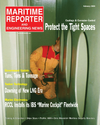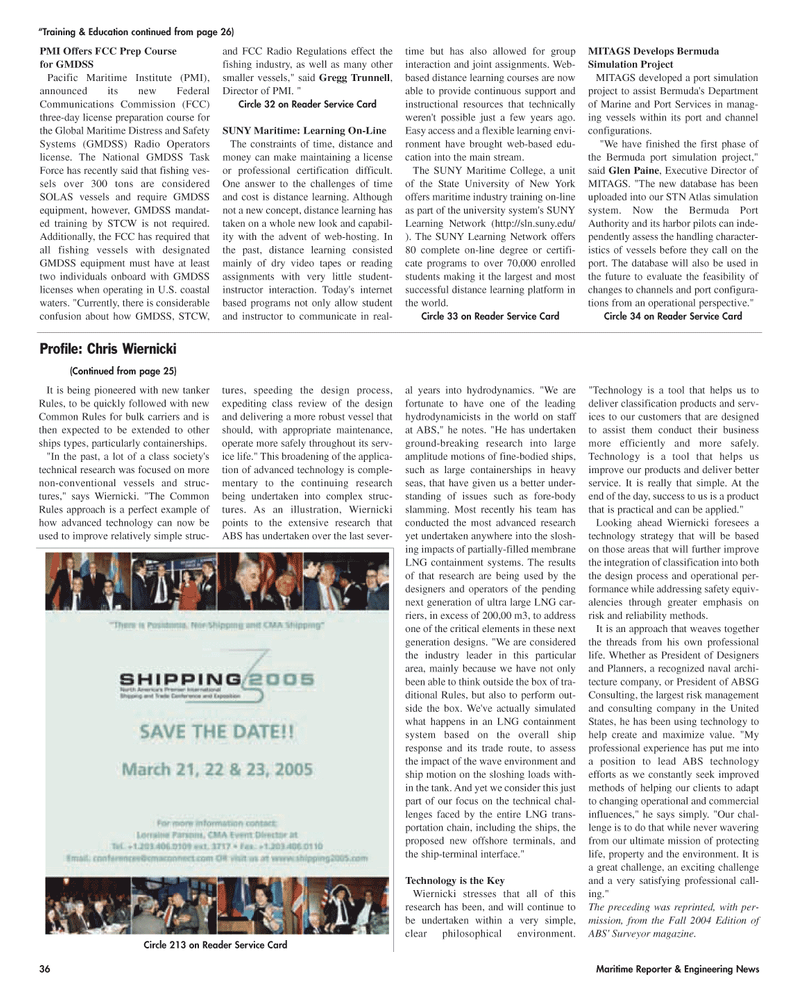
Page 36: of Maritime Reporter Magazine (February 2, 2005)
Read this page in Pdf, Flash or Html5 edition of February 2, 2005 Maritime Reporter Magazine
36 Maritime Reporter & Engineering News
It is being pioneered with new tanker
Rules, to be quickly followed with new
Common Rules for bulk carriers and is then expected to be extended to other ships types, particularly containerships. "In the past, a lot of a class society's technical research was focused on more non-conventional vessels and struc- tures," says Wiernicki. "The Common
Rules approach is a perfect example of how advanced technology can now be used to improve relatively simple struc- tures, speeding the design process, expediting class review of the design and delivering a more robust vessel that should, with appropriate maintenance, operate more safely throughout its serv- ice life." This broadening of the applica- tion of advanced technology is comple- mentary to the continuing research being undertaken into complex struc- tures. As an illustration, Wiernicki points to the extensive research that
ABS has undertaken over the last sever- al years into hydrodynamics. "We are fortunate to have one of the leading hydrodynamicists in the world on staff at ABS," he notes. "He has undertaken ground-breaking research into large amplitude motions of fine-bodied ships, such as large containerships in heavy seas, that have given us a better under- standing of issues such as fore-body slamming. Most recently his team has conducted the most advanced research yet undertaken anywhere into the slosh- ing impacts of partially-filled membrane
LNG containment systems. The results of that research are being used by the designers and operators of the pending next generation of ultra large LNG car- riers, in excess of 200,00 m3, to address one of the critical elements in these next generation designs. "We are considered the industry leader in this particular area, mainly because we have not only been able to think outside the box of tra- ditional Rules, but also to perform out- side the box. We've actually simulated what happens in an LNG containment system based on the overall ship response and its trade route, to assess the impact of the wave environment and ship motion on the sloshing loads with- in the tank. And yet we consider this just part of our focus on the technical chal- lenges faced by the entire LNG trans- portation chain, including the ships, the proposed new offshore terminals, and the ship-terminal interface."
Technology is the Key
Wiernicki stresses that all of this research has been, and will continue to be undertaken within a very simple, clear philosophical environment. "Technology is a tool that helps us to deliver classification products and serv- ices to our customers that are designed to assist them conduct their business more efficiently and more safely.
Technology is a tool that helps us improve our products and deliver better service. It is really that simple. At the end of the day, success to us is a product that is practical and can be applied."
Looking ahead Wiernicki foresees a technology strategy that will be based on those areas that will further improve the integration of classification into both the design process and operational per- formance while addressing safety equiv- alencies through greater emphasis on risk and reliability methods.
It is an approach that weaves together the threads from his own professional life. Whether as President of Designers and Planners, a recognized naval archi- tecture company, or President of ABSG
Consulting, the largest risk management and consulting company in the United
States, he has been using technology to help create and maximize value. "My professional experience has put me into a position to lead ABS technology efforts as we constantly seek improved methods of helping our clients to adapt to changing operational and commercial influences," he says simply. "Our chal- lenge is to do that while never wavering from our ultimate mission of protecting life, property and the environment. It is a great challenge, an exciting challenge and a very satisfying professional call- ing."
The preceding was reprinted, with per- mission, from the Fall 2004 Edition of
ABS' Surveyor magazine.
Circle 213 on Reader Service Card (Continued from page 25)
Profile: Chris Wiernicki
PMI Offers FCC Prep Course for GMDSS
Pacific Maritime Institute (PMI), announced its new Federal
Communications Commission (FCC) three-day license preparation course for the Global Maritime Distress and Safety
Systems (GMDSS) Radio Operators license. The National GMDSS Task
Force has recently said that fishing ves- sels over 300 tons are considered
SOLAS vessels and require GMDSS equipment, however, GMDSS mandat- ed training by STCW is not required.
Additionally, the FCC has required that all fishing vessels with designated
GMDSS equipment must have at least two individuals onboard with GMDSS licenses when operating in U.S. coastal waters. "Currently, there is considerable confusion about how GMDSS, STCW, and FCC Radio Regulations effect the fishing industry, as well as many other smaller vessels," said Gregg Trunnell,
Director of PMI. "
Circle 32 on Reader Service Card
SUNY Maritime: Learning On-Line
The constraints of time, distance and money can make maintaining a license or professional certification difficult.
One answer to the challenges of time and cost is distance learning. Although not a new concept, distance learning has taken on a whole new look and capabil- ity with the advent of web-hosting. In the past, distance learning consisted mainly of dry video tapes or reading assignments with very little student- instructor interaction. Today's internet based programs not only allow student and instructor to communicate in real- time but has also allowed for group interaction and joint assignments. Web- based distance learning courses are now able to provide continuous support and instructional resources that technically weren't possible just a few years ago.
Easy access and a flexible learning envi- ronment have brought web-based edu- cation into the main stream.
The SUNY Maritime College, a unit of the State University of New York offers maritime industry training on-line as part of the university system's SUNY
Learning Network (http://sln.suny.edu/ ). The SUNY Learning Network offers 80 complete on-line degree or certifi- cate programs to over 70,000 enrolled students making it the largest and most successful distance learning platform in the world.
Circle 33 on Reader Service Card
MITAGS Develops Bermuda
Simulation Project
MITAGS developed a port simulation project to assist Bermuda's Department of Marine and Port Services in manag- ing vessels within its port and channel configurations. "We have finished the first phase of the Bermuda port simulation project," said Glen Paine, Executive Director of
MITAGS. "The new database has been uploaded into our STN Atlas simulation system. Now the Bermuda Port
Authority and its harbor pilots can inde- pendently assess the handling character- istics of vessels before they call on the port. The database will also be used in the future to evaluate the feasibility of changes to channels and port configura- tions from an operational perspective."
Circle 34 on Reader Service Card “Training & Education continued from page 26)
MR FEBRUARY 2005 #5 (33-40).qxd 2/2/2005 9:54 AM Page 4

 35
35

 37
37
